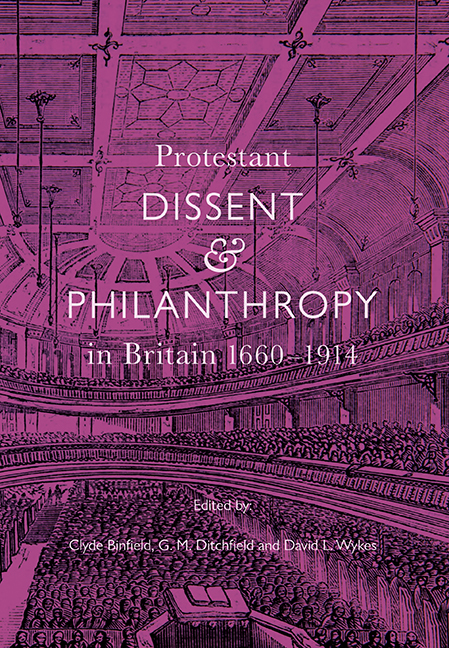Book contents
- Frontmatter
- Dedidcation
- Contents
- List of Illustrations and Tables
- List of Contributors
- Acknowledgements
- List of Abbreviations
- Introduction
- 1 Dissent and Charity, 1660–1720
- 2 Dissenters and Charity Sermons, c. 1700 to 1750
- 3 John Howard, Dissent and the Early Years of Philanthropy in Britain
- 4 Rational Philanthropy: Theory and Practice in the Emergence of British Unitarianism, c. 1750–1820
- 5 David Nasmith (1799–1839), Philanthropy Expressed as Campaigning
- 6 Building Philanthropy: The Example of Joshua Wilson (1795–1874)
- 7 Funding Faith: Early Victorian Wesleyan Philanthropy
- 8 Unitarians and Philanthropy After 1844: the Formation of a Denominational Identity
- 9 Children and Orphans: Some Nonconformist Responses to the Vulnerable in Victorian Britain
- 10 The Rowntree Family and the Evolution of Quaker Philanthropy, c. 1880 to c. 1920
- 11 ‘Not slothful in business’: Enriqueta Rylands and the John Rylands Library
- Select Bibliography
- Index
- STUDIES IN MODERN BRITISH RELIGIOUS HISTORY
7 - Funding Faith: Early Victorian Wesleyan Philanthropy
Published online by Cambridge University Press: 21 March 2020
- Frontmatter
- Dedidcation
- Contents
- List of Illustrations and Tables
- List of Contributors
- Acknowledgements
- List of Abbreviations
- Introduction
- 1 Dissent and Charity, 1660–1720
- 2 Dissenters and Charity Sermons, c. 1700 to 1750
- 3 John Howard, Dissent and the Early Years of Philanthropy in Britain
- 4 Rational Philanthropy: Theory and Practice in the Emergence of British Unitarianism, c. 1750–1820
- 5 David Nasmith (1799–1839), Philanthropy Expressed as Campaigning
- 6 Building Philanthropy: The Example of Joshua Wilson (1795–1874)
- 7 Funding Faith: Early Victorian Wesleyan Philanthropy
- 8 Unitarians and Philanthropy After 1844: the Formation of a Denominational Identity
- 9 Children and Orphans: Some Nonconformist Responses to the Vulnerable in Victorian Britain
- 10 The Rowntree Family and the Evolution of Quaker Philanthropy, c. 1880 to c. 1920
- 11 ‘Not slothful in business’: Enriqueta Rylands and the John Rylands Library
- Select Bibliography
- Index
- STUDIES IN MODERN BRITISH RELIGIOUS HISTORY
Summary
The Wesleyan Methodists are an extraordinary body. Nothing is too great or too comprehensive for them to grapple with, providing the object is the spiritual or temporal benefits of their fellow creatures. We might illustrate the truth of this by referring to those two gigantic schemes, which have been fully carried out – viz., the Wesleyan Methodist Missionary Society and the Strangers’ Friend Society: the former standing second only to the Church Missionary Society in revenue, and not surpassed in usefulness by any other; the latter standing alone – a colossal monument of the united efforts of piety and philanthropy.
(Liverpool Mail, 13 November 1838, quoted in The Watchman, 14 November 1838)These remarks were occasioned by news of the launch of the Wesleyans’ Centenary Fund. That fund seemed remarkable to contemporaries in 1838 because of its scale and likelihood of achievement. A cascade of charitable compassions was released in the eighteenth and nineteenth centuries, promoted by Dissenters, Churchmen, Quakers and, supremely, the evangelical party in the Church of England. Most Church of England projects relied on upper- and some middle-class support. In contrast, the Wesleyans, in funding chapels and preachers, tapped the sympathies of a wide group of middle- and lower-class supporters, a small number of much wealthier individuals. Indeed Wesley and his successors harboured an ambivalent attitude towards rich men in their midst, fearing their power and influence.
Fortunately for posterity, Wesleyans, like their founder, cared about statistics. Before 1914 they organised seven non-annual ‘crowd-funding’ projects for philanthropic ends. The Centenary Fund of 1839–44 was the pioneer. There followed the Wesleyan Methodist Relief and Extension fund of 1853–57, the Jubilee Fund of the Wesleyan Methodist Missionary Society of 1863–68, the Wesleyan Mission Fund of 1868, the Thanksgiving Fund (in gratitude for the admission of laymen to the Wesleyan Conference without yet another schism) of 1878–83, the Twentieth Century Fund of 1898–1908, and the Centenary Fund of the Wesleyan Methodist Missionary Society of 1911–13. Before the 1880s, as was common in newspapers during much of the nineteenth century (contrary to the teaching of Jesus, and extraordinary to twenty-first-century minds), Wesleyan (and other Methodist) donation lists published the names of donors and the sums they gave, first in the denominational weekly The Watchman and then, after the fund closed, in bound volumes, listing all subscribers and their donations by district and circuit.
- Type
- Chapter
- Information
- Protestant Dissent and Philanthropy in Britain, 1660–1914 , pp. 129 - 151Publisher: Boydell & BrewerPrint publication year: 2020



